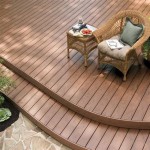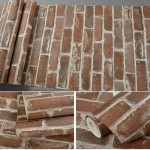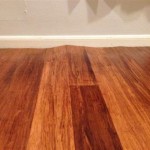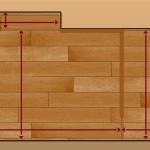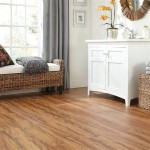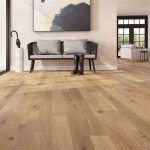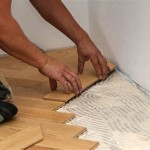How to Remove Scratches From Laminate Floor
Laminate flooring, prized for its affordability and aesthetic versatility, is a popular choice in both residential and commercial settings. Despite its durability, laminate is susceptible to scratches and scuffs caused by everyday wear and tear. These imperfections detract from the floor's overall appearance, necessitating methods for their removal or mitigation. This article provides a comprehensive guide on identifying, addressing, and preventing scratches on laminate flooring.
Understanding the Nature of Laminate Scratches
Before attempting any repair, it's crucial to understand the composition of laminate flooring and the types of scratches that can occur. Laminate flooring typically consists of four layers: a wear layer, a decorative layer, a core board, and a backing. The wear layer is a transparent, protective coating that guards against surface damage. The decorative layer is a high-resolution image that mimics wood, stone, or tile. The core board, usually made of high-density fiberboard (HDF) or medium-density fiberboard (MDF), provides structural stability. The backing provides moisture resistance and helps balance the floor. Scratches can range from superficial scuffs that only affect the wear layer to deeper gouges that penetrate the decorative layer and expose the core board.
The severity of the scratch dictates the appropriate repair method. Superficial scratches are often easily remedied with simple cleaning and polishing techniques. Deeper scratches require more involved solutions, such as color-matched fillers or laminate repair kits.
Addressing Superficial Scratches
Superficial scratches are typically hairline marks that appear as dull or faded areas on the floor's surface. These are often the easiest to address and may require minimal intervention.
Cleaning and Polishing: The first step in addressing any scratch is thorough cleaning. Use a soft-bristled broom or a vacuum cleaner with a floor brush attachment to remove loose dirt and debris. Avoid using vacuums with beater bars, as these can cause further scratching. Next, clean the floor with a laminate-specific cleaner or a mixture of mild dish soap and water. Avoid using excessive water, as moisture can seep into the seams and damage the core board. After cleaning, dry the floor thoroughly with a clean, soft cloth. Once the floor is dry, a laminate floor polish can be applied to help fill in minor scratches and restore the floor's sheen. Follow the manufacturer's instructions for application and buff the polish with a clean, dry cloth.
Using a Scratch Concealer Pen: For slightly more noticeable superficial scratches, a scratch concealer pen can be used. These pens contain a tinted solution that matches common laminate floor colors. Carefully apply the concealer pen to the scratch, following the grain of the laminate. Wipe away any excess solution with a clean, damp cloth. Allow the solution to dry completely before walking on the area.
Applying a Wax Repair Stick: Wax repair sticks are available in various colors to match different laminate floor finishes. These sticks are slightly harder than crayon and used to fill the scratched area. Choose a wax stick that closely matches the color of the laminate floor. Apply the wax by gently rubbing the stick over the scratch, filling it completely. Use a plastic putty knife to scrape away any excess wax, making sure the surface is level with the surrounding floor. Polish the repaired area with a soft cloth to blend it in with the rest of the floor.
Repairing Deeper Scratches
Deeper scratches are more prominent and penetrate beyond the wear layer, often exposing the decorative layer or the core board. These require more robust repair methods.
Laminate Repair Kits: Laminate repair kits typically include a range of colored fillers, a heating tool, and a plastic applicator. To use a repair kit, first clean the scratched area thoroughly. Select the filler color that best matches the laminate floor. If necessary, mix multiple colors to achieve a closer match. Heat the heating tool according to the manufacturer's instructions. Apply the heated tool to the filler stick and allow the filler to melt and drip into the scratch. Overfill the scratch slightly to ensure complete coverage. Allow the filler to cool and harden. Use the plastic applicator to scrape away any excess filler, making the surface flush with the surrounding floor. Finally, polish the repaired area with a soft cloth to blend it in.
Using Wood Putty or Filler: For deeper scratches that expose the core board, wood putty or filler can be used. Choose a wood putty or filler that is paintable and stainable. Clean the scratched area thoroughly and apply the wood putty or filler using a putty knife. Overfill the scratch slightly to allow for shrinkage. Allow the putty or filler to dry completely according to the manufacturer's instructions. Sand the repaired area smooth using fine-grit sandpaper, blending it seamlessly with the surrounding floor. Prime the repaired area with a wood primer. Paint or stain the repaired area to match the color of the laminate floor. Apply a clear sealant to protect the repaired area.
Replacing Damaged Planks: In cases of severe damage, such as deep gouges or extensive scratching, replacing the affected plank may be the most effective solution. This involves carefully removing the damaged plank and replacing it with a new one. The process varies depending on the type of laminate flooring. For click-lock laminate, the surrounding planks must be carefully disengaged, often requiring a tapping block and a pull bar. For glue-down laminate, the damaged plank must be cut out using a utility knife or a circular saw, and the new plank must be glued in place. It is imperative to consult the manufacturer's instructions or seek professional assistance to ensure proper installation and avoid damaging the surrounding flooring.
Preventing Scratches on Laminate Floors
Prevention is always the best approach. Implementing preventative measures can significantly reduce the occurrence of scratches and extend the life of laminate flooring.
Using Rugs and Mats: Place rugs and mats in high-traffic areas, such as entryways, hallways, and in front of sinks. These will protect the floor from dirt, debris, and abrasive materials that can cause scratches. Choose rugs and mats with non-slip backings to prevent them from sliding and causing further damage.
Protecting Furniture Legs: Attach felt pads to the legs of all furniture, including chairs, tables, sofas, and beds. These pads will create a barrier between the furniture and the floor, preventing scratches caused by movement. Regularly check the pads and replace them as needed, as they can wear down over time.
Maintaining Cleanliness: Regularly sweep or vacuum the floor to remove loose dirt and debris. Clean up spills immediately to prevent staining and water damage. Avoid using abrasive cleaners or scrub brushes, as these can scratch the floor's surface. Use a laminate-specific cleaner or a mild soap and water solution.
Avoiding High Heels and Heavy Objects: Avoid wearing high heels on laminate floors, as the pointed heels can easily dent and scratch the surface. Be careful when moving heavy objects, such as furniture or appliances. Use furniture sliders or dollies to distribute the weight and prevent scratches. Never drag heavy objects across the floor.
Controlling Pet Claws: Pets can cause significant damage to laminate floors with their claws. Trim your pet's nails regularly to minimize the risk of scratching. Consider placing scratching posts or mats in areas where your pet spends a lot of time to redirect their scratching behavior.
Using Proper Cleaning Tools: When cleaning laminate floors, use only soft-bristled brooms, microfiber mops, or vacuum cleaners with floor brush attachments. Avoid using stiff-bristled brushes, abrasive pads, or steam cleaners, as these can damage the floor's surface.
Choosing the Right Laminate Flooring: When installing laminate flooring, consider the wear layer rating. A higher wear layer rating indicates greater resistance to scratches and scuffs. Choose a laminate flooring with a wear layer rating that is appropriate for the intended use and traffic level of the area.
Professional Cleaning Services: For heavily soiled or scratched laminate floors, consider hiring a professional cleaning service. Professional cleaners have the equipment and expertise to safely and effectively clean and restore laminate flooring.
By understanding the nature of laminate scratches, employing appropriate repair methods, and implementing preventative measures, it is possible to maintain the beauty and longevity of laminate flooring. Regular maintenance and prompt attention to scratches will ensure that the floor remains an attractive and durable feature of the home or office.

How To Fix Scratches On Laminate Flooring

How To Remove Scratches From Laminate Flooring Homely Ville In 2024 Clean Cleaning Wood Floors

How To Fix Scratches On Laminate Flooring Episode 6 Howtospecialist Build Step By Diy Plans

How To Disguise Scratches And Scuff Marks On Laminate Flooring

3 Ways To Repair Laminate Floor Scratches Wikihow

How To Fix Scratches On Vinyl Plank Hardwood Laminated Floors
How To Remove Scratches From Wood Or Laminate Floors

3 Ways To Repair Laminate Floor Scratches Wikihow

7 Tips To Help Prevent Scratches On Wood Floors Flooring

How To Remove Scratches From Laminate Flooring Homely Ville
Related Posts

